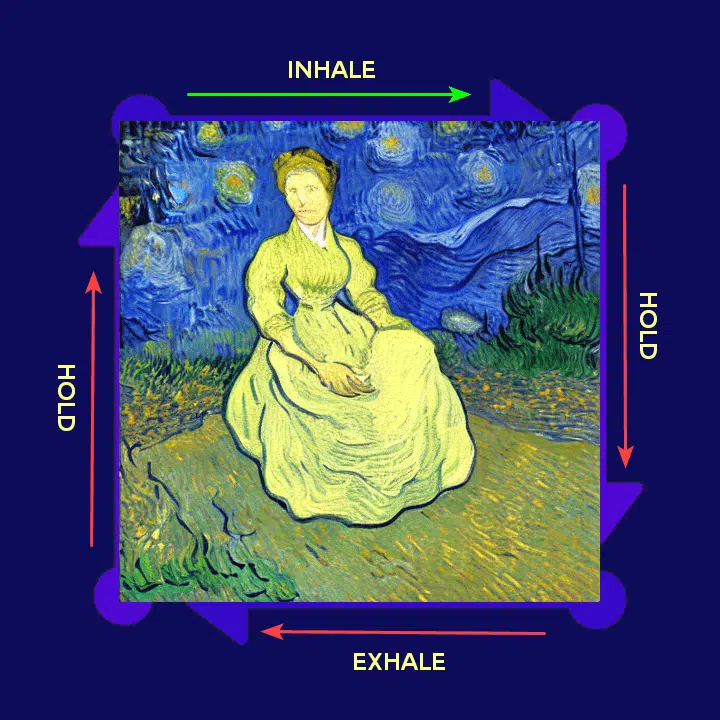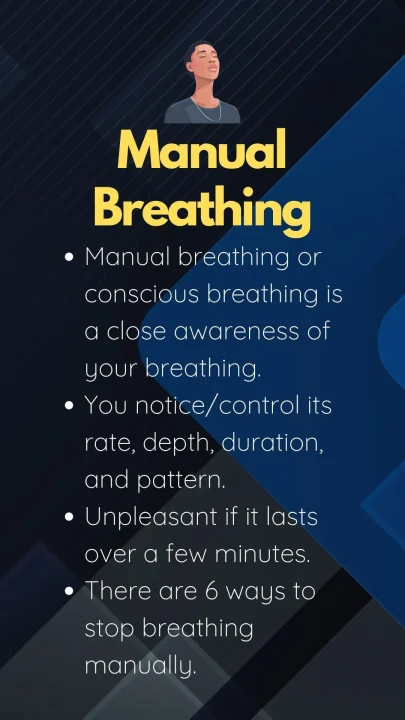— Reviewed by Dr. Sandip Roy.
Ever noticed how often you breathe every twenty-four hours?
A healthy adult takes 12–20 breaths per minute, normally. That adds up to 25,000 breaths daily! That’s a lot of breathing on autopilot.
- Hyperventilation: More than 25 breaths/minute, releases more CO2 from the body than necessary.
- Hypoventilation: Less than 8 breaths/minute, retains more CO2 than the body produces.
Most of those 25k breaths are automatic — we do not think about it.
Now try this: Focus on your breathing right now. Notice how quickly, slowly, deeply, or shallowly you’re breathing.
This type of breathing is called manual breathing or conscious breathing.
Manual breathing is stressful breathing. It makes you feel uneasy. That’s because when you notice your breaths happening, it becomes a conscious chore instead of an automatic body function.
For most people, brief periods of manual breathing can happen when they have a stressful thought or recall an unpleasant memory. But once started, manual breathing can get difficult to stop.
So, how can you stop it and get back to normal breathing?

Manual Breathing vs. Normal Breathing
Manual breathing is stressful breathing. It is an unnatural process controlled by the higher brain, as compared to our lower brain’s normal, unconscious control of breathing.
See below how manual breathing is different from normal breathing.
| Normal Breathing | Manual Breathing | Notes |
|---|---|---|
| Unconscious process | Conscious process | Manual breathing requires active focus and effort. |
| Controlled by lower brain (brainstem) | Controlled by the higher brain (cortex) | The higher brain overrides the natural breathing rhythm. |
| Automatic and effortless | Deliberate and effortful | Manual breathing can feel unnatural and tiring. |
| Largely unnoticed | Heightened awareness of breathing | Brings breathing to the forefront of attention. |
| Occurs at a regular, relaxed pace | Can involve irregular patterns (e.g., holding breath, rapid breathing) | Disrupts the normal breathing cycle. |
| Happens naturally, without thought | Often triggered by stress, anxiety, or unpleasant memories | Can induce or exacerbate feelings of anxiety. |
| Uncommon in the general population | More common in those with Generalized Anxiety Disorder (GAD) or Panic Disorder (PD) | A frequent symptom of these conditions. |
| No breath-holding | Some can purposely hold their breath to induce feelings of suffocation (false alarm) | A dangerous practice that can worsen the symptoms of their disorder. |
The good news is there are easy techniques to stop manually breathing and return to your natural, unconscious breathing rhythm. We explore six of those methods next.
How To Stop Manual Breathing & Ease Your Stressful Breathing
Stress, anxiety, or panic can all cause you to breathe manually.
However, there are breathing techniques to help you normalize your breathing and eliminate anxiety-related manual breathing. These techniques are often used in yoga, meditation, and relaxation exercises.
Here are six breathing techniques to stop manually breathing:
1. Box Breathing
Box breathing helps you concentrate by controlling your inhales, exhales and breath holds.
It can improve focus and concentration, and can be especially beneficial for those who work in jobs that need a lot of attention.
Here’s how to do it:
Imagine or gaze at a square painting on a wall. You could also draw a square on the wall. Take each side as a time-guide for inhalation, hold, exhalation, and hold.

- First, breathe in through your nose for 4 seconds (the top line).
- Then, hold your breath for 4 seconds (the right-side line).
- Next, breathe out for 4 seconds (the bottom line).
- Finally, hold for 4 more seconds (the left-side line).
Repeat this box pattern of 4-second inhales/holds/exhales/holds, like drawing and redrawing a square in the air with your breaths.
This technique can help calm your mind when you feel anxious or unfocused. It is also one of the simplest ways to refresh your mind.
2. Double inhale with a long exhale
In this, you take in a long inhale, and at the end of it take in a short rapid extra inhale. Then exhale a long breath.
This method is believed to increase oxygen levels in the body and stimulate the nervous system, helping to reduce stress, increase focus and clarity, and boost physical performance.
It can also help to activate the relaxation response in the body, calming the mind and reducing anxiety.
You may practice the double inhale method for a few minutes each day, or as many times as you need it throughout the day to manage stress and improve overall well-being.
This manual breathing method has been popularized by Stanford neuroscientist Dr. Andrew Huberman. He calls it the “physiological sigh” and suggests it is a natural process we often see in babies and pets.
3. Controlled Breathing or Diaphragmatic Breathing
Have you ever taken a really deep breath and felt calmer afterward?
That’s because deep breathing can help relax your body and mind. One way to do this is called controlled or diaphragmatic breathing.
The diaphragm is the muscle that separates your chest from your gut area. When you breathe deeply, you use your diaphragm muscle more than regular shallow breathing.
This stimulates your vagus nerve, which is connected to the part of your nervous system that helps you enter the “rest and digest” mode.
This is how to practice diaphragmatic breathing:
- Breathe in slowly through your nose, letting your belly push out.
- Then breathe out through your mouth, letting your belly sink in.
- Repeat this slow deep breathing for several minutes.
As your body gets extra oxygen, you start to have a sense of control over your thoughts and emotions, feeling more relaxed.
“In particular, changing one’s breathing toward a slower and deeper breathing pattern is a well-known strategy to acutely increase cardiac vagal control, as reflected by an increase in heart rate variability along with the respiratory rhythm.”
— D’Agostini & Claes, 2022

4. Alternate Nostril Breathing
Alternate nostril breathing is a yoga technique where you breathe in through one nostril and out through the other nostril.
It can help lower your blood pressure, heart rate, and anxiety levels, as well as improve your respiratory endurance.
Here’s how to do it:
- Sit up straight and use your thumb to close your right nostril.
- Breathe in through your left nostril with the right nostril closed.
- After a full inhalation, close your left nostril.
- Then breathe out through the right nostril.
- Keep alternating nostrils as you breathe in and out for up to 5 minutes.
According to ancient Indian Yoga practices, there are two ways to do it:
- Anulom vilom pranayama: Inhaling through one nostril and exhaling through the other. Then, reversing the nostrils for inhaling and exhaling.
- Nadi shodhana: Like above, but in this, you hold your breath for a few seconds before exhaling.
5. Mindful Breathing
Mindful breathing means paying close attention to each breath.
Here’s how to do it:
- Find a quiet place to sit, set a timer for 5–10 minutes, and close your eyes.
- Focus just on the sensation of air moving in and out of your body.
- Count “1” as you inhale, “2” as you exhale, and repeat.
Your mind will probably wander off many times — that’s normal!
When your attention wanders, gently bring it back to your breathing. Act like you are helping your best friend learn how to breathe in a new way.
6. Distraction
Sometimes the best way to stop thinking about your breathing is to distract yourself.
Psychologists have also found that distraction is one of the most helpful ways to stop overthinking.
- Do things that bring instant joy, like dancing to TikTok videos.
- Focus on a task that is focus-intense, like jigsaw puzzles.
- Challenge your anxious thoughts or recall positive memories.
My go-to distractions are making and having a good cup of coffee, doing 30 pushups, or watching a video on YouTube.
They help break the cycle of over-focusing on my breaths, and settle into my natural breathing.
Types of Manual Breathing
Now, manual breathing can be of two types:
- Stress-induced
- Intention-induced
| Type | Stress-Induced Manual Breathing | Intentional Manual Breathing |
|---|---|---|
| Description | Becoming aware of breathing due to increased stress or anxiety in daily life | Intentionally and deliberately focusing on and controlling one’s breathing pattern |
| Triggers | Stressful situations, unpleasant thoughts/memories | Conscious effort, breathing exercises, meditation practices |
| Effects | Heightened awareness of abnormal breathing patterns (heavy, rapid, held breath) which adds discomfort to the existing stress | Can become uncomfortable or exhausting if done for too long as it requires constant higher brain focus |
| Notes | Stress and manual breathing can create a cyclical pattern of increasing discomfort | May be done purposefully for certain reasons, such as managing panic disorder symptoms |
| Examples | Noticing shallow breathing during a work presentation | Practicing diaphragmatic breathing or breath-counting meditation |
This study found that voluntary breath-holding duration is not a suitable test to measure carbon dioxide sensitivity or suffocation alarm threshold in panic disorder.
4 Benefits of Controlling Your Breathing
- Stress Reduction: Slowing your rate and taking deep breaths activates the calming part of your nervous system. You’ll feel more relaxed.
- Increased Lung Capacity: Deep, controlled breaths allow your lungs to fully expand, improving respiratory health.
- Better Focus: Techniques like breath counting train your brain to notice thoughts without judgment, improving concentration.
- Improved Sleep: Controlled breathing before bed can help treat insomnia without medications, and get more restful sleep.
Final Words
Our mental state can affect how we breathe, and how we breathe can affect how we think.
Reverse-engineer the process. Take a few deep breaths to calm your mind and slow your racing thoughts.
Finally, a simple way to improve your breathing is to sit up straight. It lets your lungs expand more fully, which allows better exchange of oxygen and carbon dioxide.
√ Also Read: R.A.I.N. Method of Mindfulness Meditation: A Precise Guide
√ Please spread the word if you found this helpful.
• Our Story!
